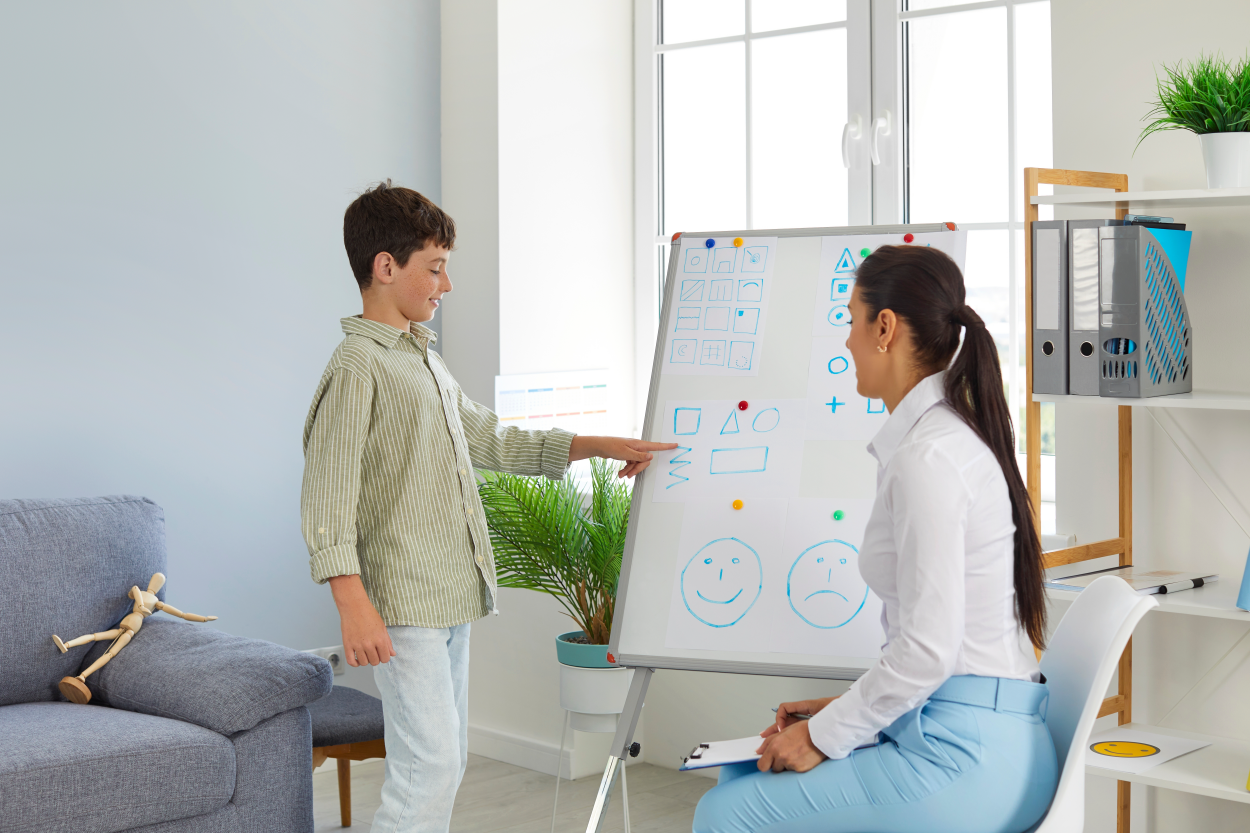The benefits of a multisensory experience in therapy
By Ashley Heintzelman
February 2023

Since the beginning of the pandemic, I have been providing and receiving in-person and virtual therapy. Initially, my own therapy was 70% virtual and 30% in person, and my client schedule averaged about 60% in person and 40% virtual. Being on both sides of the couch gave me a unique perspective to consider the advantages and limitations of virtual therapy.
I have always viewed my own therapy process as staying active at the “mental gym” to help me cope with anxiety and for self-care. My anxiety symptoms manifest with challenges regarding perfectionism and being cognitively inflexible during times of change. Unsurprisingly, the COVID-19 pandemic triggered my anxiety.
Although it was not an initial goal of my own therapy, I relearned something I had known about myself and human nature: our need to use all our senses and connect the mind with the body. Throughout this process, I discovered that in-person therapy best meets my needs (and most likely my clients’ needs) because virtual therapy often lacks a multisensory experience.
Finding the right fit
I have attended therapy throughout my professional life, but moving to a new home, raising children and other life challenges have led to periods without therapy. When the pandemic began, I was not currently engaged in counseling, but I recognized the added stress of these circumstances for everyone, including me, made this a good time to continue therapy again.
I had several goals this time. First, I wanted to process coping with the same issues many others faced as the pandemic progressed (e.g., school closings, vaccination decisions). Second, I explored how the pandemic affected me professionally as a therapist. Clients typically do not know much about the lives of their therapists unless mental health professionals choose to self-disclose. The idea that the pandemic and telehealth might lead to added exposure of my personal life to clients triggered a fear of loss of competently managing the potential changes in the therapeutic relationship. I wanted to ensure I found a good balance of self-disclosure for my clients.
When I decided to reenter therapy in 2020, I found a counselor who offered only virtual appointments. Telehealth was more accessible for me with my responsibilities at the time, and it also made sense given the uncertainties of life and the shifting work schedules during the pandemic. I was lucky to find Sophia (pseudonym). She was a good fit for me. She is soft-spoken, nonjudgmental, gently challenging and intelligent. She conveyed support and understanding and shared additional perspectives. Sophia appropriately self-disclosed about her experiences as a clinician and working parent of young children during the pandemic. I felt she understood my anxieties. Her compassion and shared experiences helped normalize and diffuse my fears. And she helped me set realistic expectations of myself.
Even though I was making good progress with Sophia and most of my own work as a therapist was virtual, I felt something was missing from my virtual sessions with her. I just couldn’t put my finger on it yet. It wasn’t until I experienced multisensory engagement in therapy again that I realized that was what was missing.
A multisensory experience
In the spring of 2021, I decided to transition to a new counselor — one I could meet in person. A good friend and colleague recommended I see Lily (pseudonym), a therapist my friend thought would be a good fit for me. When I started with Lily, I felt immediate comfort and ease with her.
During my third session, we explored whether I needed a shift in work-life balance and discussed the potential barriers that made that change difficult. Lily responded saying, “I need to draw this out.” She then drew a model concept of what we discussed regarding my shame, anxiety and boundaries on a whiteboard. We were in sync concerning the model; it made sense to me.
The model created one of those powerful moments in therapy where I felt understood and validated. The use of the whiteboard also highlighted the multisensory experience that I felt was missing during my virtual sessions with Sophia. I could now better articulate how I felt after seeing what she was saying drawn out. The model also contained the trigger point where my anxiety would begin to ramp up, so it allowed me to gain a new coping strategy that I could use moving forward when I felt anxious because I could better understand what started an irrational thought loop. The visual display of my feelings and fears helped me gain a new perspective about my emotions. After Lily finished the whiteboard model, I took a picture of her drawing using my cell phone, which allowed me to view it whenever I felt overwhelmed.
Lily continues to use the whiteboard in session with me, and every time, I process even more sensory details from the experience. I have noticed, for example, that Lily is left-handed, and the slant of her wrist reminds me of my left-handed daughter. I have often watched her dangly earrings bounce while her arm moves when writing, and I have observed how her nail colors change with the seasons.
Being in person also engages my senses in other ways. I sometimes contemplate the exact shade of the moody dark gray paint in her office. I have noticed how the office smells of mint and vanilla, and I wonder if the scent is the remains of essential oils or a candle. I hear the hum of the white noise machine in the hall. Lily’s calming energy permeates the room — a full in-person experience matters in many ways. And I feel safe on her couch, sitting next to a soft blanket in her warm office.
The exposure of all my senses to the surroundings helps me stay grounded during our sessions. The multisensory engagement creates a calming effect on my whole body — one I could not have experienced remotely from a screen. In addition, the surroundings and in-person contact enhance my ability to fully take in Lily’s feedback. Although a multisensory experience is not necessary for change, this experience with Lily reminded me of what I often miss when doing virtual therapy: the benefit of engaging the mind and body.
My knowledge and experiences are consistent with research on the science of calm approach to emotional well-being and the neuroscience of learning, which emphasizes that we learn best when multiple senses are stimulated. For example, Dr. Daniel Siegel, a prominent mindfulness researcher, explored learning to focus and become more aware via practices using our five senses and feeling of connection to other people in his 2020 book Aware: The Science and Practice of Presence — The Groundbreaking Mediation Practice. Dr. Siegel found that sensory experiences and feelings of connection to others promote the growth of neural connections, leading to less stress and anxiety. Thus, the lack of a three-dimensional experience that activates all the senses and helps to stimulate novel ideas could hold clients back from powerful and lasting breakthroughs.
The whiteboard exercise that Lily used during our session symbolizes the strength of the therapeutic alliance. It instantly reminded me of my vulnerability as well as Lily’s unconditional positive regard and brilliant conceptualizing skills. And the experience also helped me learn a new cognitive and emotional framework for coping. This opportunity was therapy at its finest.
Incorporating sensory elements with clients
Drawing on my personal experience in therapy, I continue to think about how to incorporate multisensory experiences during my own professional sessions with clients. In the past, I mapped out client conceptualizations of presenting concerns or coping strategies on paper during sessions. But based on my experience with Lily, I realized how I was underutilizing multisensory engagement as a therapeutic tool. Using the large windows in my office and pens made for writing on glass, I can map and draw out concepts to help clients have more sensory experiences, which will help them visual it better.
I am also seeking to experience my senses and body movements in the presence of clients and recognize the clients’ bodies and movements and verbal descriptions of sensory and emotional experiences. For example, I am now more attuned to clients’ and my own body language after observing Lily’s body language when drawing on the whiteboard.
Clinicians can also explore how to increase multisensory engagement virtually and consider if certain clients may benefit more from multisensory and in-person sessions. For example, clients with anxiety who have a treatment goal of calming their overactive sympathetic nervous system may benefit more from in-person counseling than a client who is primarily working on improving depressive symptoms.
Because the pandemic is ongoing and our lives are demanding, we must be realistic. The convenience of virtual sessions will likely continue to create demand among clients. It’s important to remember that having a therapist who is a good fit is always a better choice than not going to counseling because of a lack of in-person opportunities. Therefore, the best-case scenario might be a hybrid model, depending on the clients’ and therapists’ joint decisions. But no matter if counseling is virtual or in person, I encourage other clinicians to find ways to emphasize the sensory experience in session, including visually mapping concepts.
 Ashley Heintzelman is a licensed psychologist who specializes in the treatment of eating disorders. She is the founder of the Ampersand Psych Clinic in Overland Park, Kansas, and co-author of the book Free to Be: The Non-Diet Path to Peace With Foodand Body. Her other clinical passions include mentoring early career professionals and supervising graduate students in training to become counselors. Contact her at heintzelman.ashley@gmail.com or through her website at ampersandpsychclinic.com.
Ashley Heintzelman is a licensed psychologist who specializes in the treatment of eating disorders. She is the founder of the Ampersand Psych Clinic in Overland Park, Kansas, and co-author of the book Free to Be: The Non-Diet Path to Peace With Foodand Body. Her other clinical passions include mentoring early career professionals and supervising graduate students in training to become counselors. Contact her at heintzelman.ashley@gmail.com or through her website at ampersandpsychclinic.com.
Counseling Today reviews unsolicited articles written by American Counseling Association members. To access writing guidelines and tips for having an article accepted for publication, visit ct.counseling.org/feedback.
Opinions expressed and statements made in articles appearing in Counseling Today do not necessarily represent the opinions of the editors or policies of the American Counseling Association.


